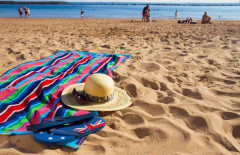Sunbathing Three Times A Year Can Increase The Risk Of Getting Endometriosis, Study Says
Using tanning beds and exposure to UVA (Ultraviolet A) not only increase the risk of developing malignant melanoma, which is the most dangerous form of skin cancer, but also increase the risk of getting endometriosis, according to a new study.
The study appears in the journal Human Reproduction, one of the world's leading reproductive medicine journals. It found that the more young women use tanning beds or sunscreen, and get sunburned during their teens and young adulthood, the higher the risk of getting endometriosis will be.

The long-term condition usually causes pain and causes tissues like the lining of the uterus to start growing in other areas, such as the ovaries and oviducts. Symptoms include lower abdominal pain, back or pelvic pain, severe menstrual pain, and pain during or after sexual intercourse. But conversely, the researchers also found that women who spent years in areas with high levels of natural UVB (Ultraviolet B) were less likely to be diagnosed with endometriosis.
Specifically, women who lived in the sunniest areas at birth have a reduced risk of getting endometriosis at the age of 15 to 30, compared with women who lived in the sunniest areas of the United States each year. This means that four out of every 100 women in the U.S who live in areas with the highest UV levels at age 15 are at risk of developing endometriosis, and nearly six out of every 100 women who live in areas with the lowest UV levels are at risk.
The secret is that natural sunlight is mainly the UVB, which can boost vitamin D, enhance immunity and suppress inflammation. Tanning is mainly caused by the UVA, which is known to damage cells and adversely affect immunity.
After adjusting factors that might have influenced the results, the researchers found that compared with women who never use tanning beds, those who use tanning beds six or more times a year in adolescence or at young ages have an increased risk of getting endometriosis by 19%. If they use tanning beds six or more times a year between the ages of 25 and 35, the risk will be increased by 24%. If they use tanning beds three or more times a year during those two periods, the risk will be increased by 30%.
While the exact mechanism between endometriosis and melanoma is not clear, some studies have found that women who are sensitive to sunlight, do not tan easily, have red hair, light eyes, freckles or lots of moles have an increased risk of getting endometriosis. The findings were based on a study of 116,429 white women, aged 25 to 42. They joined American Nurses' Health Study II in 1989.
Beginning in 1993, participants were asked if they had endometriosis diagnosed by laparoscopy, which is the gold standard for the correct diagnosis of the disease. Of the 95,080 women who participated in the study, 4,791 cases were diagnosed with endometriosis by laparoscopy during follow-ups, the study found.
"There is much we do not know about the relationship between the risk of endometriosis and exposure to sunlight in recreation and residential areas," the researchers said. "However, our findings suggest that avoiding excessive leisure sun exposure and tanning beds may reduce the risk of getting endometriosis." So women should follow health advice, avoid using tanning beds, avoid sunburn with covers, and use a broad-spectrum UVA/UVB sunscreen to protect your skin from the sun.
You may also be interested in:
A Therapeutic Target For Endometriosis That Triggers Dysmenorrhea And Infertility Has Been Identified
previous pageEndometriosis -- A Modern Disease That Endangers The Health Of Women
next page
You may also be interested in
- Endometriosis and Debilitating Bowel & Bladder Pain: Diagnosis, Treatments, and Hope for Relief
- Struggling with Endometriosis Symptoms? Proven Back Pain and Painful Sex Relief Options
- Severe Endometriosis Treatment: Chronic Pelvic Pain Relief and Infertility Solutions
- New Endometriosis Pill Approved on NHS: What This Means for Patients and the Role of Traditional Chinese Medicine
- Can Endometriosis Be Endured Until Menopause?
Testimonials
- Adenomyosis with Ureaplasma Urealyticum Cured by Fuyan Pill
- Tubal blockage with hydrosalpinx can be cured by TCM shortly
- Fuyan Pill Helps A woman with Adenomyosis Get Pregnant
- A Woman with Hydrosalpinx Is Cured with Fuyan pill
- Pelvic Inflammatory Disease Testimonials
- Irregular Vaginal Bleeding and Endometrial Thickening Cured by Fuyan Pill
- Pruritus Vulvae and Frequent Urination: Mycoplasma Infection Cured after 2 Courses



